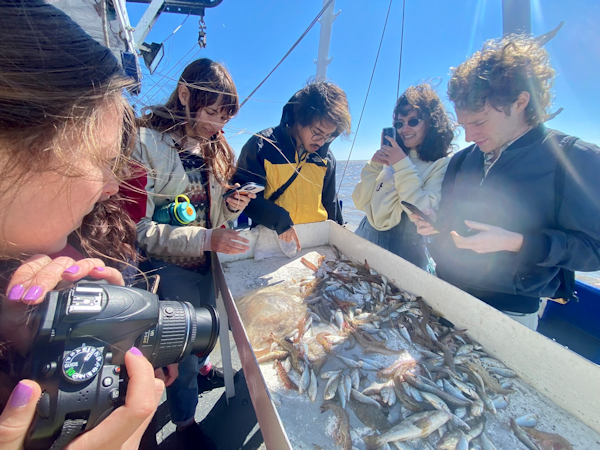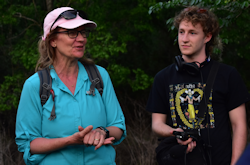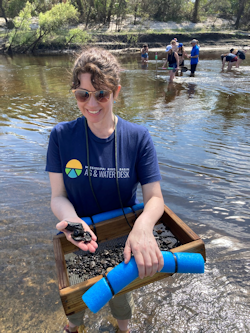SEJournal Online is the digital news magazine of the Society of Environmental Journalists. Learn more about SEJournal Online, including submission, subscription and advertising information.
 |
 |
| Students traveled aboard the research vessel Acadiana into Barataria Bay off coastal Louisiana to examine marine creatures that can survive in the oxygen-depleted zone caused by upstream runoff. Photo: Sara Shipley Hiles. |
EJ Academy: Missouri, Florida Journalism Professors Join Classes on Multistate Fertilizer Investigation
By Cynthia Barnett and Sara Shipley Hiles
It started with a dream to build a field course for journalism students that would report on the cycle of fertilizer and its consequences: From the phosphate mines of rural Florida to the farm fields of the Midwest, down the Mississippi River and to the Gulf of Mexico’s “dead zone.”
We daydreamed about the idea at the Society of Environmental Journalists’ annual conferences over the years.
Our aspirations culminated in June 2023 when 18 student journalists published the multistate fertilizer investigation, “The Price of Plenty,” in the Missouri School of Journalism’s Columbia Missourian and the University of Florida’s WUFT News. Numerous professional outlets, including Investigate Midwest, The Times-Picayune, the Miami Herald, Modern Farmer and WLRN-FM, Florida’s largest public radio station, picked up all or part of the five-part series.
‘I learned so much about
journalism but also life.’
— UF senior Elliot Tritto.
“I learned so much about journalism but also life,” said UF senior Elliot Tritto. Like many of the students, Elliot joined the project with only a vague sense of nitrogen and phosphorus from high school chemistry class.
For us, the project felt like peak teaching: using our years of journalism experience and connections to give students the challenges and opportunities they needed to finish college with a major work of explanatory reporting.
We learned plenty, too.
Planting the seeds
Such a project doesn’t happen overnight. We both felt strongly that these students, who got sent home from college their freshman year due to the pandemic, deserved a great field experience with boots-on-the-ground reporting.
 |
| Barnett with one of the 18 students involved in the joint project. Photo: Lauren Whiddon. |
That would take funding. Sara had some student travel money and a teaching assistant. Cynthia tapped a competitive fund for field courses set up by the UF journalism department.
By fall, we were in conversations with Steve Sapienza, senior strategist for news partnerships at the Pulitzer Center for Crisis Reporting. The center ultimately agreed to fund travel and other expenses through its nationwide Connected Coastlines climate reporting initiative. Our Pulitzer grants — $20,000 to Mizzou and $16,000 to UF — meant student journalists would not have to bear any expenses.
We began recruiting students who’d be willing to spend spring break visiting agrochemical plants. That’s a pretty special group.
We each brought on nine students for a 16-week, advanced science and environment reporting class. Cynthia hired a former student, Arizona Republic climate reporter Joan Meiners, as an adjunct to oversee data analysis. Sara hired teaching assistant Dan Mika, an MU graduate student who specializes in investigative business reporting.
Coordinating a team of two dozen across two time zones, we set our class times to overlap for an hour one day a week. We scheduled expert speakers over Zoom and assigned readings to give students a foundation on fertilizer and how other journalists had covered it. We built a suite of shared tools, including Google folders, a data repository and an active Slack channel. Working across geographic areas wasn’t hard; it helped students think more expansively about their stories and reach beyond their own regions for experts.
Our first task was to dig into the industry by obtaining business records, talking to sources, looking up environmental data and speaking with experienced journalists, many of them SEJers who had covered the story. We led the students in researching and developing story ideas, which they then had to pitch to panels of professional journalists. Each student tackled a long-form piece complete with visuals and data.
Muddy boots
 |
| Hiles at central Florida’s Peace River, hunting for fossils that helped form phosphate deposits. Photo: Cynthia Barnett. |
The highlights of the semester, and the reporting, were two, multiday trips that brought the students together from Columbia and Gainesville. Strangers over Zoom, they became close along Florida’s Bone Valley and Louisiana’s Cancer Alley.
Cynthia coordinated a three-day trip to central Florida. We paddled the Peace River to hunt for the fossils of ancient sea creatures that helped form the state’s phosphate deposits. We spent a day at The Mosaic Co.’s Four Corners phosphate mine, where students got to clamber up a piece of mining equipment called a dragline that’s as big as a football field.
Sara planned the five-day trip to Louisiana, where she had attended college and worked at The Times-Picayune. The students interviewed scientists, activists and residents of fenceline communities along the Mississippi River. At the coast, we boarded the research vessel Acadiana and motored into Barataria Bay with researchers who study hypoxia caused by upstream runoff. The students got to haul up research nets and examine marine creatures that can survive in the oxygen-depleted zone.
That night, we had dinner with members of the Houma Nation to learn about historic and ongoing threats to land and fishing communities. Students asked questions late into the night. Environmental justice was a strong theme in the published project.
The student journalists also had some eye-opening experiences. During a driving tour of mega fertilizer-chemical plants along the Mississippi River in St. James Parish, a local sheriff’s deputy stopped and questioned us — twice — for taking pictures of the sites.
Growing as teachers
The “Price of Plenty” was by far the most ambitious project either of us had tackled with undergraduates. After that first pitch session, we were worried. By the time we read their final drafts, we were elated.
The project’s 18 in-depth stories reported on timely issues such as soaring fertilizer costs, the 2023 Farm Bill and the hunt for rare earth elements in Florida’s phosphate mines. The students dug deep into the climate crisis, analyzing the industry’s fossil fuel emissions and questioning the vulnerability of its mines, plants and huge waste mountains called gypstacks to extreme rains and hurricanes. They investigated their own universities — and whether the politically powerful fertilizer industry has too much control over public research agendas.
If we could do it over, we’d plan a
yearlong senior capstone experience,
rather than a one-semester class.
If we could do it over, we’d plan a yearlong senior capstone experience, rather than a one-semester class. The six weeks remaining after spring break were an uncomfortable crunch that had us both at our desks every weekend. Follow-up reporting, writing, editing, fact-checking and production ramped up as the end-of-semester deadline neared. Almost all the students were graduating seniors, so the stories had to get done.
Production teams in our respective newsrooms built the sites. In hindsight, it would have been a better experience for the students to produce their own stories online. We also wished we’d had them create a social media campaign to better push out the stories.
One thing we wouldn’t change is our partnership. We share intense work habits and often joked that we couldn’t imagine anyone else putting up with us. We learned to be flexible about our different teaching styles and work schedules — Cynthia the early bird, Sara the night owl. We edited our own students — and each other’s. It made for a lot of early mornings and long nights.
Both of us moms, we told students how enterprise projects are like having a baby. After months of work, there’s a painful push at the end and then you have this beautiful thing with a life of its own.
Cynthia Barnett is the environmental journalist in residence at the University of Florida College of Journalism and Communications. Sara Shipley Hiles is an associate professor at the University of Missouri School of Journalism and executive director of the Mississippi River Basin Ag & Water Desk.
* From the weekly news magazine SEJournal Online, Vol. 8, No. 31. Content from each new issue of SEJournal Online is available to the public via the SEJournal Online main page. Subscribe to the e-newsletter here. And see past issues of the SEJournal archived here.












 Advertisement
Advertisement 



